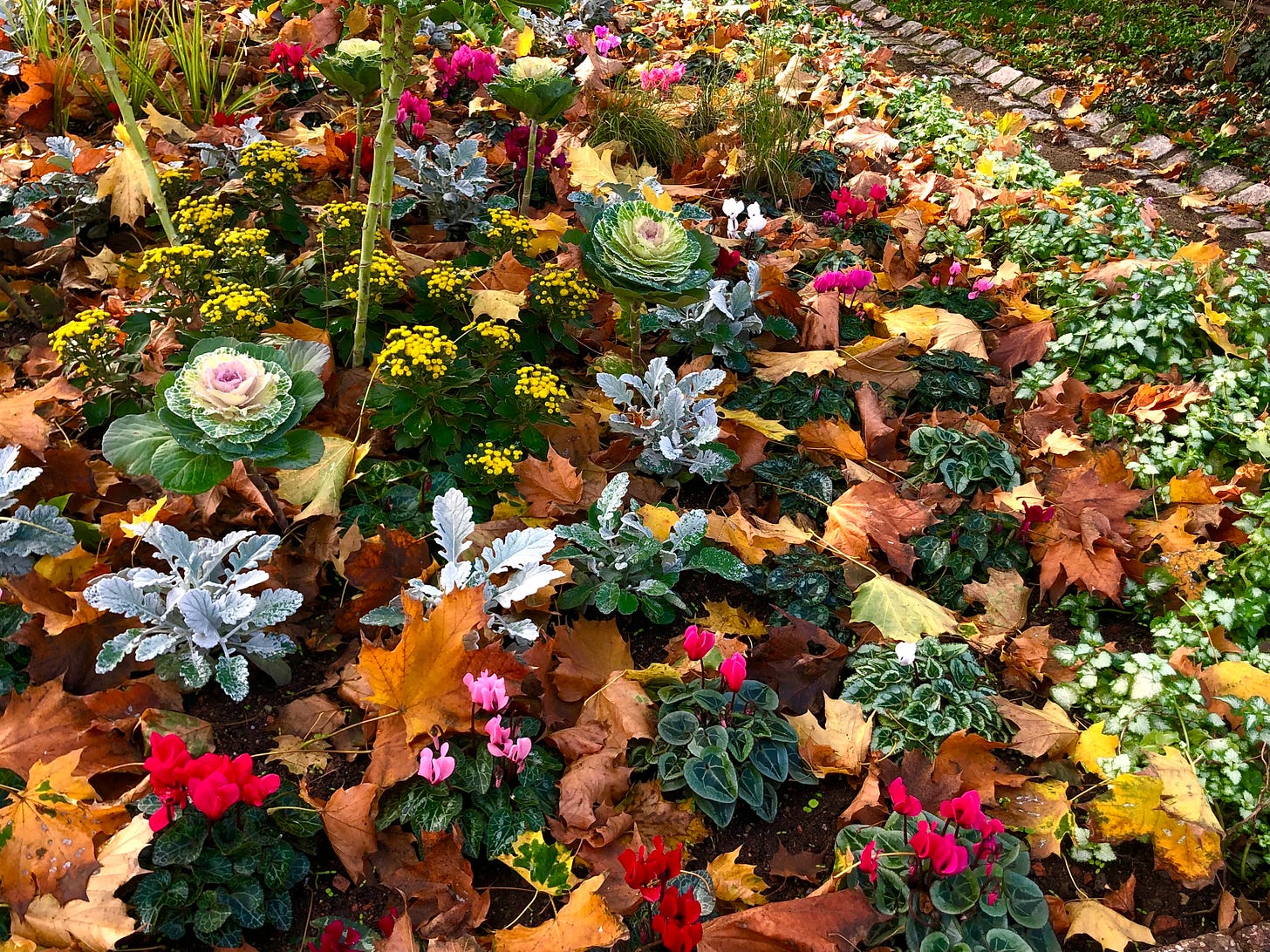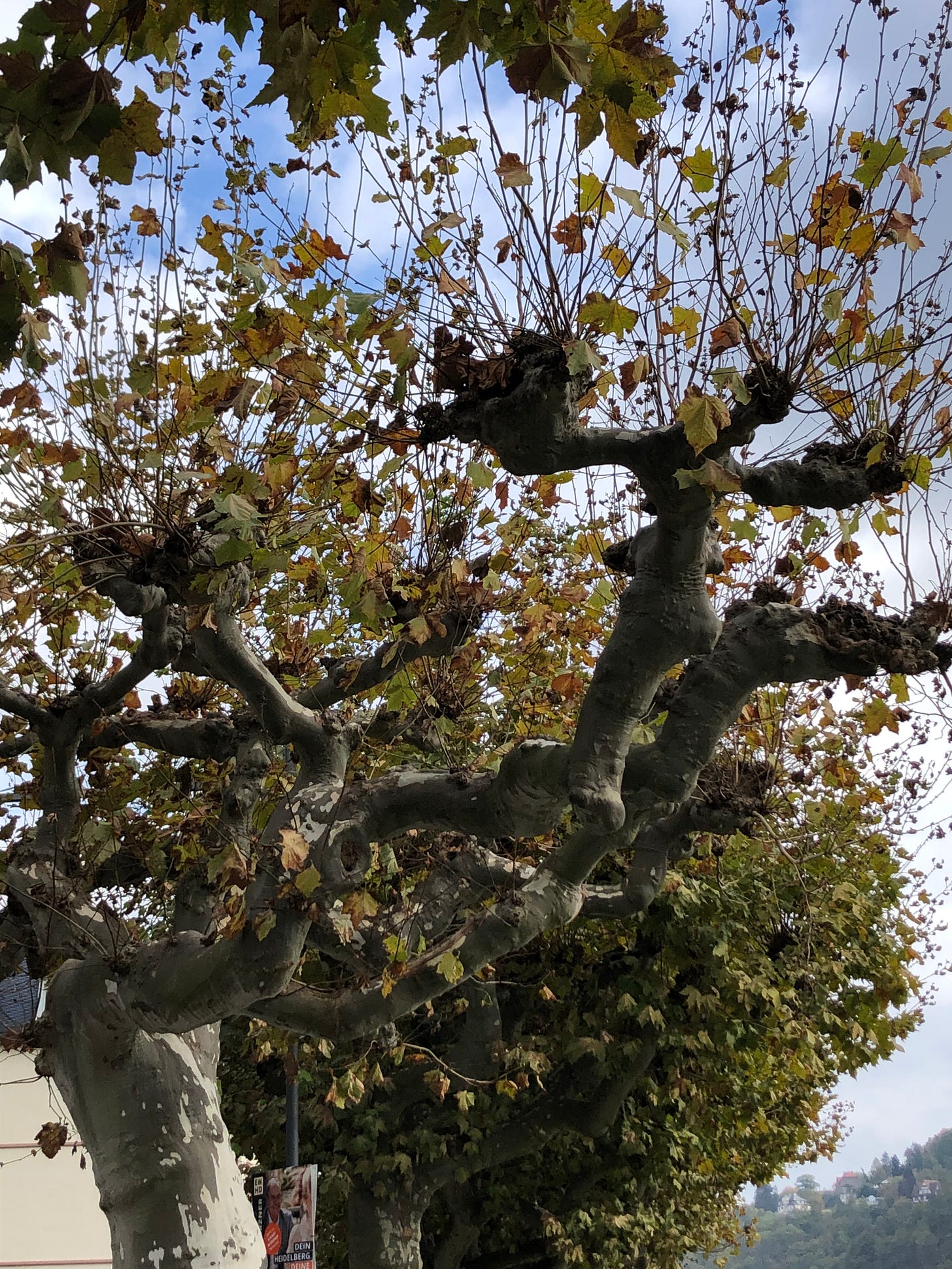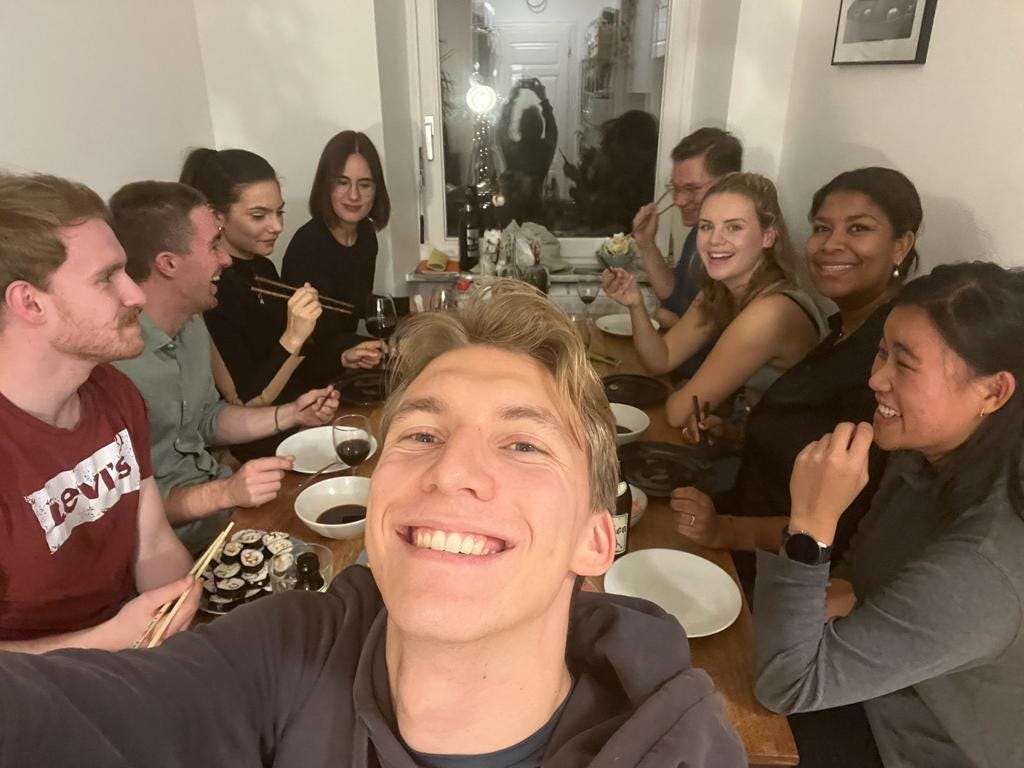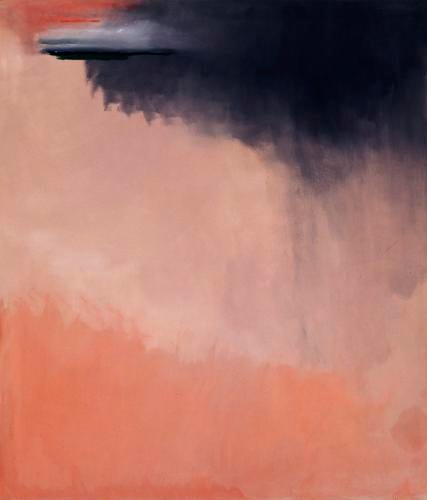Week 08: Cold Feet
The saying "to have cold feet" typically means backing out of a commitment. I had cold feet committing to booking tickets...and from sleeping in a frigid room one hour away from Frankfurt.
Order Up
Spontaneous" stems from Latin in which sponte meant "of one's free will, voluntarily" and multiple dictionaries concur that spontaneous is synonymous with impulsive. This was my week: spontaneous, impulsive, and meeting a random friend of Isa's who is studying abroad in Munich named Will.
I love having the flexibility to make plans on a whim with people I might have just met but hated buying multiple transportation tickets that were simply, not free. My heart was happy this week, however, filled with curious museums, meaningful conversation, long walks and runs, and of course, bureaucracy. They say absence makes the heart grow fonder so I abstain, courteously, from ever visiting the Bezirksamt for visa business again.
The Bread
Top Slice: It was a week of re-visiting the old in order to explore something new. Running around Hamburg, I found a new museum with a friend nestled in the middle of nowhere, got lost in sections of the Friedhof Ohlsdorf I have never seen, made more tree friends, and hiked higher up in the hills of Heidelberg.
Bottom Slice: I'm looking forward to a somewhat pseudo-calm-busy week. The first half will be slower paced and spent in the library. The second half will be spent in sunny Spain and begging passport control to take me back (more on this below). Please don't break-up with me.
The Filling
It’s all about the chemistry.
Sometimes there are just people you meet that you immediately click with, a friend of a friend or a random person you strike up a conversation with. I seem to be drawn to people who embrace this mindset and warmth and ended up with multiple plus-ones to spontaneous excursions. On Wednesday, I went to the Deutsches Zusatzstoffmuseum or the German Additive Substance Museum which is an obscure but incredibly stimulating and interactive museum packed into three rooms. I would never have thought to go myself, but a friend struck up a random conversation at dinner with Anastacia, a Ukranian-Russian student who is now looking for a job in Hamburg. I was not there but heard about it second-hand and ended up reaching out to spend the day showing her around the city.
The museum was a gem and everyone who comes to visit me in Hamburg will be forced to spend a romantic date learning about every single chemical the European Union allows to be added to food. It was like dating reality TV shows: terrifying but impossible to look away from. I learned so many random facts and one of my favourites was that margarine was the love child of Napolean the III and Hippolyte Mèges-Mouries. They wanted to boost the morale of troops during the war by beautifying butter but it was a classic example of chemical cat-fishing—its pretty much all oil and is truly high-maintenance: here is a nine-page love letter proving love relies on chemistry.
We bonded over coffee, a love of art and the famed Documenta art show that takes place in Kassel, Germany, and inevitably, the conflict in Russia. I am so conditioned to rhetoric from the US media that hearing perspectives directly from people affected or in the throe of it has not only challenged my views, but also underscores the importance of questioning everything and not becoming complacent or lost in systems designed to dictate what constitutes a meaningful life—mostly centred around work productivity and relying on external affirmation or prestige.
I appreciate more every day growing up with teachers or professors who modelled other ways to live and to find fulfilment. They help me question things constantly and so do conversations with those from different cultural and educational backgrounds. Yet, I think one of the reasons it was so easy to connect with Anastacia aside from our shared love for niche knowledge, is simply, our generation’s shared anxieties not only for our human selves but the non-human. We read the energy crisis as a consequence of violence against people, but an energy crisis is the violence of the earth itself. We begin to modify our work structures to conserve human’s energy but yet do not apply the same ethos of anti-extraction to our ecological systems. I finished a brilliant book recommendation by a friend from Bowdoin called “How I Became a Tree” by Sumana Roy.
Matthew Hall, in his book Plants as Persons, makes an important point behind the marginalization of plant life in our consciousness—it is their lack of violence.
A series of essays weaving together ecological, ancestral, and written knowledge surrounding trees, I cannot recommend it highly enough and while conversations of our generation on climate often are despondent, inseparable from a violence known since we grew up, Roy simultaneously centres the human life and plant life as radically co-dependent, in which radical is not bound only to politics but a radicalisation of the self. Co-dependency has negative connotations that are often tied to romantic relationships—the dream is to find our freedoms by being untied to a person. However, radical co-dependency asks us to do the tough labour of acknowledging that these decisions need to be made together—they affect each other drastically even when we want to have nothing to do with either the person or the physical world. As a society we have marginalised the natural world as a tract of land to fight over or annex rather than recognising peace may lie in the natural world inherently and we cannot extract it. It has already been modelled and we need to begin to be radically co-dependent.
Another student from the U.S. studying abroad in Munich visited Isa in Hamburg. Since it was such a busy week, I was just expecting to say hello and goodbye as I was, coincidently, at the train station at the same time. However, his train ride home was cancelled and so I ended up feeding him dinner back at the dorm, having a great climbing session since he brought his shoes “just in case” and got to hear about the differences in structure between Gilford College’s program in Munich and ours. There were obvious pros and cons to each—having a more internal program that is not through the university brings students from the US closer together and he was lucky to be in a homestay. On the other hand, living in a student dormitory has allowed me to slowly but surely get to know other German students, taste their incredible baked goods and swap recipes, and talk about the dating scene and norms in Europe.
The way to a person’s heart is through their stomach.
I visited my friend Paul Meistermann in Heidelberg and got to meet his flatmates and other students in his law cohort who were lovely. Apparently a popular phrase for the city is “Ich hab' mein Herz in Heidelberg verloren” or I lost my heart in Heidelberg. I was suspicious as it sounded like a copy and paste phrase that could be applied to any whimsical place, but it is apparently a song? Can’t confirm whether it is any good or just like my spontaneous and improvised cooking at home. Also can’t confirm whether I’ve lost my heart but I did in fact, lose my matcha tea and spilled it all over myself on the bridge which is supposedly quite romantic. It was definitely memorable.
I truly had such a lovely visit. We watched a mediocre film, ate very good food, made sushi, and found a lot of green things. On the weekend I took myself on a run along the river visiting the other Heidelberg campus which is huge and full of the medical and science centres. Paul and I were trying to wrack our brains at what we did last time I visited in 2019 and I couldn’t even remember where Helena and I had come from in Europe. Directly from Überlingen? London? Iowa?
I do remember vividly going up the enclosed and rocky staircases, steep and curving around a hill that directly looks out on the old city. Helena, I, and her cousin Sophia did not make it very high up but I remember being so enthralled by the cobblestones that merged into cement walls, hidden with vines and overgrowth. The air walking up, as cliche as it sounds, felt like it had been standing, suspending in this place for ages. Not stagnant, but more so quiet and observing even with how full the path was with people. It is a popular question always what one would pick: mountains, oceans, forests, or desert. The most popular answer is definitely mountains but for some reason, even though I have lived in such close proximity for the last few years, I still would always answer water or plains. I love the vastness of water where the horizon looks like a slow, steady streak of paint dividing two distinct yet clearly connected sections; almost something like a Frankenthaler piece. But yet, the moment I saw the beautiful green hills of Heidelberg from the train, I sighed in relief. Maybe I am drawn to simple forms and lines, something like cut outs in the sky, placed carefully like a collage.
Despite the romantic air of the city wit its red brick, running past the vast hospital-like campus north of the Neckar and Alstadt re-established my theory that architects and city planners are the biggest commitment-phobes of us all. Waterways are often natural indicators which cities are built around, and in the United States, natural barriers that can reinforce class and racial differences. If the geo-political boundaries of the super young US seem complicated, Europe’s appear to me overwhelming as they have constantly shifted for thousands of years. As we hiked up the hills in Heidelberg (Paul was a good hiking buddy even though my fast feet left him in the dust) I thought about how today we understand monuments and built artefacts as discrete moments in a linear timeline. We went all the way up to the Thingstätte which is a massive amphitheatre that was built by the Nazi Party to emulate Greek architecture and was one of four hundred other planned open air theatres.
An article from failedarchitecture.com claims that Heidelberg served as an ideal location for to construct the theatre as the city was a “bastion of Romanticism.” Romanticism as in the era, not the moonlit walks or sunsets or venmo-ing your partner money for gas, cannot be understood as a discrete timeline. Scholars still argue when it emerged, from whom, and when it ended. The birth of who said it first/who thought of it is a hot topic and averts being pinned down to one sole person again and again. We tend to read architecture, even in art history, as something that is firm and connected cleanly to a set time, empire, or strain of thought. The Nazi Party saw the potential for positioning themselves within a greater heritage—Greek architecture is paradigmatic of the emergence of Western empire as well—and chose to do so through architecture. We see history embodied, literally, in the standing buildings almost always planned with an agenda in mind.
The hesitation of local authorities to deal with the amphitheatre and the resulting lack of institutionalisation leaves the place open for Heidelberg’s inhabitants to appropriate it according to their wishes. The people, not the state, lead the management of memory. —Cécile Poulot, an art historian who graduated from Heidelberg University
This is one reason the debate rages on about monuments, plaques, and memorials. Their creators had an intent and the implication in today’s society are uneasy. If we believe we have cleanly cut ties from dangerous thought and doctrines, we should cut ourselves free from objects that are physical manifestations of them.

Yet winding up the hill with many off-shoot paths woven with plaques, towers, inscribed rocks, and ‘ruins’ like the Thingstätte, complicates time and forced me to think of architecture more as a river than the static impression it leaves on the viewer. The Thingstätte plays mind games and without prior background knowledge, leaves a false impression. Our contemporary understanding of goals are modelled linearly, where we keep moving toward the peak. If you want to find the most impressive things, they are found at the end of the path. The best relationships are the ones that last the longest and are marked by clear milestones like dating for a year or getting engaged or moving in together. And so, the Thingstätte would seem to be the thing. After knowing the history, however, you are forced to question the age of each memorial you stumble up the hill. The newest artefacts may be at the base but might be right before the Thingstätte or intertwined with the Alstadt or somewhere else entirely. We should not understand architecture as a clean timeline of thought or culture and when we build walls, castles, and fences to protect our geo-political boundaries, we fall in love again and again with false promises.
The Sauce
On a lighter note, the sauce this week will be spicy but sweet and heavy on the heat.
As a wise man in a low ponytail and white tights once said, “Don’t modulate the key then not debate with me.” There is apparently, a German version of Hamilton the musical which many of my program members attended so they can attest to the translation, but in our speaking class we focused on modular verbs. Honestly, it is probably my favourite grammar lesson so far as you use the verbs sollen (should) and wollen (to want) to talk about something you heard second-hand or while gossiping or bragging about yourself. You also use other verbs like dürfen and können to indicate an assumption based on a level of certainty. For example, you would use mussen to express that someone has to or had to do something whereas können would be used for they could have. Uncertainty it terrible for political debates but sexy for not making commitments. I should not have slept through my train connection and gotten stranded in Frankfurt en route to Heidelberg and had to spontaneously rebook tickets, but it happened. It could be possible that it happened once again when I slept through multiple alarms and bought duplicate tickets in a drowsy state. It might have been because my room was freezing and I was moving slowly due to my frozen toes, but who’s to say? It’s up for debate and you don’t have to be married to the idea.
Rumour has it that I never wear pants and its already November. As in, I am fond of running around the downtown in shorts in contrast to everyone bundled in coats that skim their ankles. It makes sense that people stare, but when you’re used to sleet and snow and wind bombarding your eyes in Iowa, temperatures above freezing seem dreamy. Until I fall head over heels, as in literally go tumbling on slick ice, the shorts will stay and somehow Europeans (except the French that made an entire film about “Claire’s Knee) haven’t gotten the hint that the best way to seduce someone is by committing to leaving your legs out.
Mystery Meat
I Can't Believe Its Not The CN Tower! Or the Seattle Needle! Or the stack of plates that my floor-mates in my dorm put illogically and precariously in the cupboard. Instead last week's photo was the Heinrich Hertz-Turm nestled in the Japanese Garden—the largest of its kind in Europe—which is just spectacular and part of the greater Planten und Blomen park. I cross through the park every-time I walk from the campus to my climbing gym and keep discovering small, new treasures each time.The park is multi-purpose from a skating rink in the winter, the Old Botanical Garden, tea houses, an apothecary garden, music pavilion, and used to be a 17th century bastion with a moat to protect the city. Talk about being indecisive, guarded, and putting up walls...
Anywho, cold feet are better than the crunch of ceramics under my feet in the kitchen. Continuously moving keeps me from committing to a fully domestic lifestyle buying perfectly glazed and matching sets of pottery from the weekly market. Severus Snape sums up commitment issues in two words: "Scared, Potter?"










Messaged ya but I'm pretty sure it's a sycamore maple (Acer pseudoplatanus) https://www.inaturalist.org/taxa/119791-Acer-pseudoplatanus. Common introduced ornamental in the US. Check for the characteristic floaty seed case thingies. <3